Birding In Bed – A Year In Nocmig
Part Two – The Birds
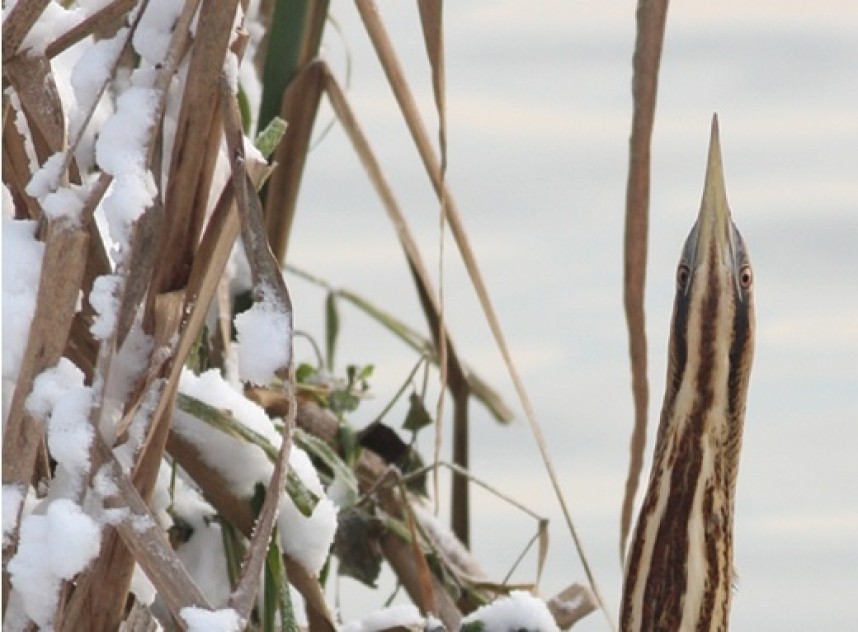
Bitterns – stars of the show at both Flamborough and Filey © Mark Pearson
As described in Part One, at the end of March last year, with an indefinite lockdown beginning, birding opportunities narrowing, and crucially, Common Scoters audibly beeping outside my bathroom window in the night sky, it was time to give nocturnal migration recording (nocmig) a try.
More than a year on, and it's been a godsend, in a variety of ways: as a distraction in trying times, as a (steep) learning curve for new birding skills and knowledge, as a new method of understanding and appreciating local bird migration, and ultimately, as a little mystery treasure trove to open every morning....
For the first few months it was all about the recorder jammed into the gap in my study window and pointed out into the alley here in Filey town; but by late summer (thanks to YCN!), I'd expanded my set-up, and I was able to run no fewer than three recorders regularly – the second up on the North Cliff here in Filey, and the third over the bay, in a garden in Flamborough Village.
While Part One looked at the how, why, when and where of nocmig, in this second and final part we'll look at the month-by-month results from each location – and it's fair to say, they greatly exceeded all our expectations....
'Graow!' - The first of the Bitterns, over Filey North Cliff
April
Filey Town
Highlights: hundreds of Common Scoters - the species that kick-started it all!; nine wader species, including four Little Ringed Plovers, the first Greenshank and Grey Plover; two Blackcaps (an unexpected thrill over these urban rooftops!); plenty of wildfowl including Gadwall, Wigeon and Pochard; numerous rails (especially Moorhens and Coots); and lots of returning Scandinavian thrushes, including three figures of Redwings.
Most abundant - Common Scoters (288), Redwing (168), Oystercatcher (38), Common Sandpiper (13)
Most regular - Redwing (57% of nights), Common Scoter (43%), Oystercatcher (37%)
May
Filey Town
Highlights: Two QUAILS (10th & 25th) – a joy to pick out among the screaming gulls in the dead of night!; a wider variety of waders, including the first Sanderlings, Knot and Turnstones; the first terns - both Sandwich and Arctic; and several long-distance migratory songbirds, including two Lesser Whitethroats, Spotted Flycatcher and a Yellow Wagtail.
Most abundant - Oystercatcher (59), Moorhen (24), Whimbrel (14), Dunlin (12)
Most regular - Oystercatcher (68%), Moorhen (48%), Little Ringed Plover & Grey Heron (both 23%)
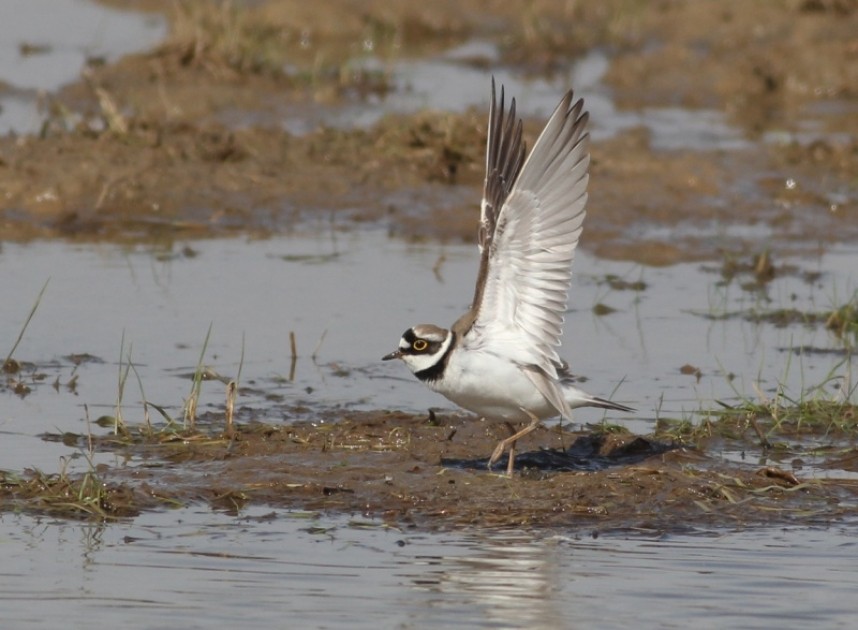
Nocturnally migrating Little Ringed Plovers – a sure sign of the spring proper © Mark Pearson
June
Filey Town
Highlights: plenty of rails (numerous Moorhens, plus Water Rails and Coot); Little Grebes, another Spotted Flycatcher, and (presumably returning) Common Scoter - but, the Herring Gull colony noise was increasingly overwhelming....
Most abundant - Moorhen (30), Oystercatcher (19), Grey Heron (11), Curlew (8)
Most regular - Moorhen (40%), Oystercatcher (37%), Grey Heron (27%), Curlew (13%)
July
Filey
Highlights: recording began from the 10th on the North Cliff here in Filey, which was instantly productive: highlights included a BITTERN (23rd) – a less than annual species here in Filey and a wonderful early reward; twelve wader species (including four Little Ringed Plovers, lots of Curlew and Whimbrel, Turnstones, Knot, Grey and Golden Plovers); three Water Rails, Common Scoters and much more - a wealth of variety and abundance! The Filey Town recorder was mothballed on 12th due to the Herring Gull colony noise, but still clocked plenty of Curlews, Moorhens and a few other species before then.
Most abundant (North Cliff) - Curlew (35), Dunlin (21), Oystercatcher (20), Redshank (13)
Most regular (North Cliff) - Curlew & Oystercatcher (both 60%), Dunlin (40%), Redshank (35%)
August
Filey North Cliff
Highlights: exceptional shorebird (wader) migration, for both quality and quantity - sustained and often heavy passage with a monthly tally of 17 species (!), which included: both Bar- and Black-tailed Godwits, multiple Green and Common Sandpipers, good numbers of Whimbrel, Sanderling, Dunlin, Curlew, Turnstone and Ringed Plovers, and impressive movements of Oystercatchers (with e.g. at least 68 on 9th). Also Arctic, Common and Sandwich Terns, and a surprise Short-eared Owl (tying in with a diurnal mini-influx) on 16th.
Most abundant - Oystercatcher (156), Curlew (42), Sanderling & Dunlin (both 27), Ringed Plover (16)
Most regular - Oystercatcher (81%), Curlew (73%), Ringed Plover & Dunlin (both 38%)
The unmistakable screech of Sandwich Terns heading over Filey town in the dead of night
Filey Town
Highlights: active again from the 14th, and within the still dominant gull noise, a Tree Pipit (29th), ten wader species including Turnstone, Knot, three Common Sandpipers and 13 Redshank, plus Sandwich and Common Terns were all bonuses under the challenging circumstances!
Most abundant - Dunlin (18%), Redshank (13), Oystercatcher (8)
Most regular - Dunlin (38%), Redshank (31%), Oystercatcher (22%)
Flamborough
Highlights: active from the 10th, and as with the Filey North Cliff results, a fantastic month for shorebird migration... 16 wader species, including Wood Sandpiper (a scarce bird at Flamborough), Sanderling, Knot, both Godwits, Grey, Little Ringed and Golden Plovers, good numbers of Ringed Plovers, Oystercatchers and Redshank, and a Tree Pipit (15th).
Most abundant - Oystercatcher (88), Redshank (64), Ringed Plover (13)
Most regular - Oystercatcher (94%), Ringed Plover (35%), Golden Plover, Dunlin and Redshank (24%)
September
Filey North Cliff
Highlights included a Little Egret (16th), a good cast of waders (but in much smaller numbers than the previous month), and – particularly towards the end of the month - passerines: Skylarks, Song Thrushes, Robins, Tree Pipit, Goldcrest (30th) and, incredibly, a YELLOW-BROWED WARBLER (29th)!
Most abundant - Curlew (21), Grey Heron (16), Dunlin & Pink-footed Goose (11)
Most regular - Curlew (45%), Skylark & Oystercatcher (32%), Black-headed Gull (27%)
Filey Town
Highlights: still much reduced coverage due to the gull colony, but a steady improvement from mid-month, with up half each night's recording mostly checkable by the end of the month – which yielded a selection of waders (in small numbers), and passerines including Redwings, Robins and Meadow Pipits.
Most regular - Oystercatcher (32%); Dunlin, Snipe, Great Black-backed & Black-headed Gulls (all 11%)
Flamborough
Highlights: passerines including Song Thrushes, Meadow Pipits, Robins and Redwings (the latter with an early notable arrival of 68 on 27th), and pulses of wader passage, including movements of Knot and Dunlin mid-month.
Most abundant - Redwing (73), Dunlin (15), Knot (12)
Most regular - Robin (24%), Sandwich Tern, Redwing, Song Thrush (all 18%)
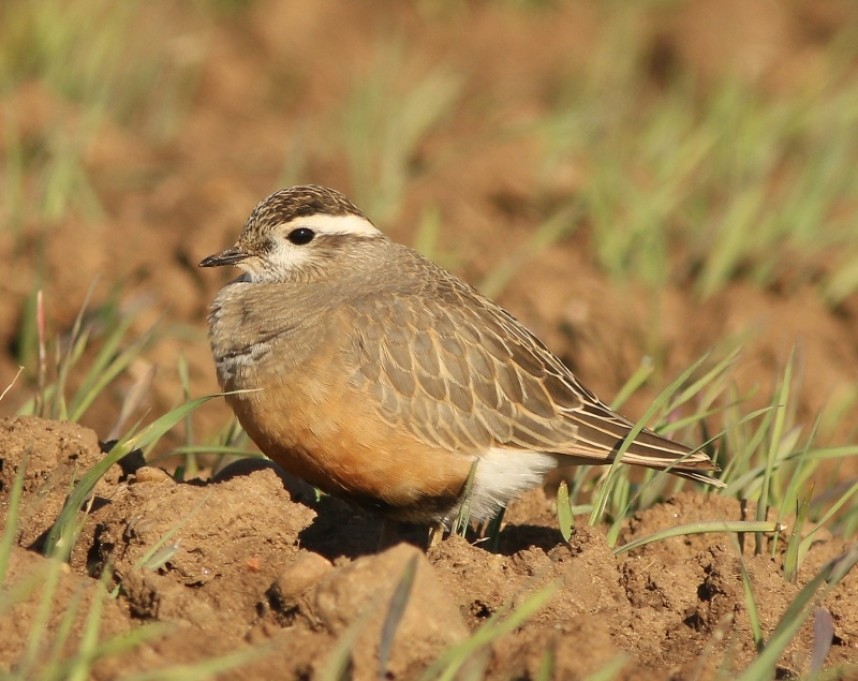
A Dotterel migrating over the back alley on the night of 7th October was a stand-out highlight © Mark Pearson
October
Filey Town
Highlights: a DOTTEREL on 7th was a fantastic surprise, and a local rarity, only recorded every few years diurnally in Filey; good numbers of Pink-feet, and a large flock of Whooper Swans on 22nd; a wide variety of late autumn passerines, including Bramblings, Robins, Meadow Pipits and Chaffinches; memorable, record-breaking thrush immigration, with thousands of Redwings and Blackbirds, as well as many Song Thrushes, Fieldfares and three Ring Ouzels.
Most abundant - Redwing (4,219), Blackbird (1,175), Pink-footed Goose (82), Fieldfare (80)
Most regular - Redwing (69%), Blackbird (54%), Song Thrush (31%), Fieldfare (23%)
Filey North Cliff
Highlights:several notable thrush nights, with e.g. 1,553 Redwings on 13th; a wide variety of passerines, including 12 Robins, a late Tree Pipit (5th), two Dunnocks, Lesser Redpoll, Reed Bunting and Chaffinch; small numbers of waders & Pink-feet, and an interaction between (local) Little Owls (a rare bird in the area).
Most abundant - Redwing (2,335), Blackbird (434), Pink-footed Goose (55)
Most regular - Redwing (64%), Robin and Song Thrush (both 57%)
Flamborough village
Highlights: good movements of Pink-feet, Whooper Swans, late season shorebirds (Snipe, Knot, many Dunlins), passerines including a Goldcrest (23rd), heavy thrush arrivals.
Most abundant - Redwing (881), Pink-footed Goose (215), Blackbird (213)
Most regular - Redwing (73%), Blackbird (50%), Song Thrush (35%)
November
Filey Town
Highlights: an exceptional influx of winter geese, with six species recorded – most notably, multiple Bean Geese and Barnacle Geese, several flocks of Russian White-fronted Geese, and numerous, often large skeins of Pink-footed Geese; lots of shorebird activity, with e.g. six Grey Plovers, big numbers of Dunlins and Golden Plovers, plus Snipe, Lapwings and more; Common Scoters, rails, gulls, more Whooper Swans and wildfowl (particularly Wigeon); record-breaking influxes of Blackbirds, as well as big numbers of other thrushes... what a month!
Most abundant - Blackbird (2,932), Redwing (1,682), Pink-footed Goose (1017), Dunlin (81)
Most regular - Redwing (96%), Blackbird (62%), Song Thrush (46%)
Filey North Cliff
Highlights: plenty of action (but interestingly, not nearly as much as the town recorder) – Russian White-fronted Geese, Whooper Swans, lots of Pink-feet, notable thrush influxes, other passerines including Robins and six Bramblings.
Most abundant - Pink-footed Goose (621), Blackbird (565), Starling (200), Redwing (198)
Most regular - Blackbird (100%), Redwing (89%), Pink-footed Goose (67%)
Flamborough
Highlights: Lapland Bunting (3rd); Russian White-fronted Geese, lots of Whooper Swans and Pink-feet; notable thrush influxes; waders including Bar-tailed Godwit and Knot.
Most abundant - Redwing (763), Blackbird (554), Pink-footed Goose (70)
Most regular - Redwing (75%), Blackbird (60%), Robin (25%)
A few of the thousands of Redwings recorded in the small hours over the last year.....
December
Filey Town
The Goosefest continued... !Yet more White-fronted Geese, Barnacle Geese, huge movements of Pink-footed Geese; small numbers of waders and wildfowl and small but regular pushes of thrushes.
Most abundant - Redwing (763), Blackbird (554), Pink-footed Goose (70)
Most regular - Redwing (75%), Blackbird (60%), Robin (25%)
Very little recording took place in December at North Cliff & Flamborough due weather / practical reasons, with the intention being to resume activities there in early spring....
January and February
Filey North Cliff
A couple of attempts in January produced Snipe and Mallard before a further eight in February, with Oystercatchers, Snipe, Blackbirds and Song Thrushes from the off; by mid-month, Pink-footed Geese, Wigeon, Lapwings and a mini-movements of Redwings stirred the pot, with further additions of Coot, Moorhen, Skylarks, Gadwall, Golden Plover and Teal in the third week.
So far, so good, but then on the night of the 25th, nocmig gold - a STONE-CURLEW (only the third ever for Filey), followed by the ghostly howl of a singing Great Northern Diver on 28th!
Filey Town
A Redwing at 0206hrs on Jan 1st even beat the Herring Gulls - a good omen?! Otherwise quiet, with Mallards, Common Gulls, Blackbirds, Song Thrushes, Wigeon and Teal in small numbers, odd Moorhens and Golden Plover, a few skeins of Pink-footed Geese, and the highlight - a flock of Barnacle Geese on 12th. February was a little busier, with new additions including Grey Plover, Fieldfare, Lapwing, Coot and other expected early spring migrants, with a nice surprise first for the house on 21st, a Pintail.
Flamborough
Recording commenced from mid-Feb, with Wigeon, Teal, Pink-footed Geese, Moorhens, Coots, Dunlins, Curlews, Lapwings, Blackbirds, Song Thrushes and other early spring movers logged in small numbers, with highlights including a Whooper Swan on 24th and various double-figure Redwing counts, including 47 on 18th.
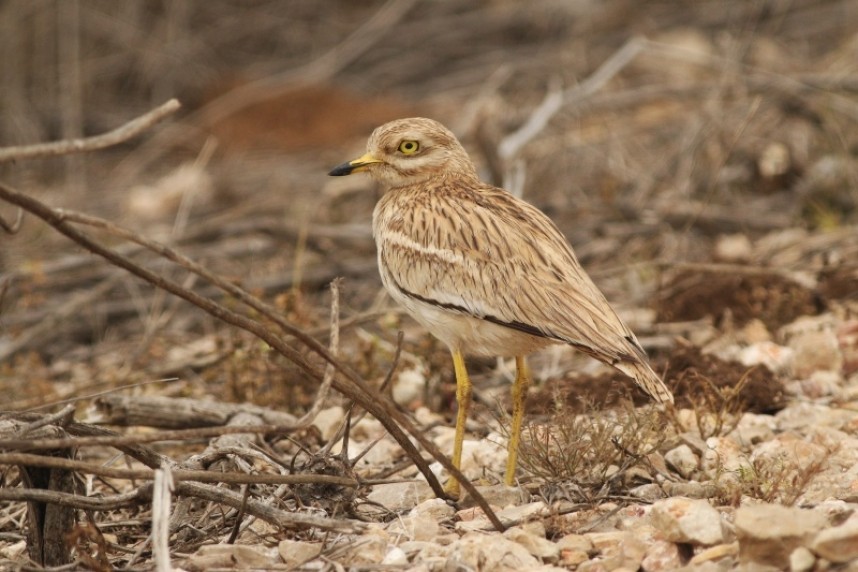
A Stone-curlew over Filey North Cliff in late February was a wonderful surprise © Mark Pearson
March
Filey Town
Regular Oystercatchers, Black-headed Gulls, Wigeon and Moorhens; shorebird diversity improved as the month went on, with Curlew, Knot, Dunlin, Redshank, Grey and Golden Plovers, plus Coot, Water Rail, and increasing numbers of winter thrushes. Common Scoter flocks featured from 21st, plus Whooper Swans (also 21st), and the highlight – at least two Bean Geese on 13th, a less-than-annual species here in Filey, honking throatily over the chimney pots.
Most abundant - Blackbird (236), Redwing (92), Common Scoter (48)
Most regular - Redwing and Oystercatcher (both 64%), Moorhen (50%)
Filey North Cliff
Teal, Moorhen, Snipe, Grey Plover, Gadwall, Water Rail, Grey Heron, odd passerines (including Skylark) and a bonus Pintail all featured early on; Common Scoters enlivened recordings from 18th, with Whoopers, Pink-feet and Wigeon, and notable departures of Blackbirds (including 214 on 22nd) following. Lots more scoter flocks followed over several nights, with Golden Plovers, Snipe, small gulls and Redwing movements late month.
Most abundant - Blackbird (276), Redwing (227), Common Scoter (74)
Most regular - Redwing (73%), Moorhen (64%), Blackbird (59%)
Flamborough
Regular Teal, Moorhens, Redwings and Song Thrushes from early on, with Curlew, Oystercatcher, Coot, Skylark, Blackbird and Robin soon added; both Curlew and Redwing clocked significant counts – with e.g. 82 of the former and several flocks of the latter on 17th. Snipe, Grey Heron, Golden Plover, Knot, Dunlin and more were soon added, Wigeon and Curlew movements grew late in the month, but Scoters stole the show with 25 flocks in total. The bird of the month, however, was the Eurasian Bittern which croaked twice over the recorder on 22nd; a less-than-annual rarity on the Head (with two more to follow in April!).
Most abundant - Redwing (457), Common Scoter (116), Blackbird (84)
Most regular - Redwing (90%), Moorhen (58%), Blackbird (45%)
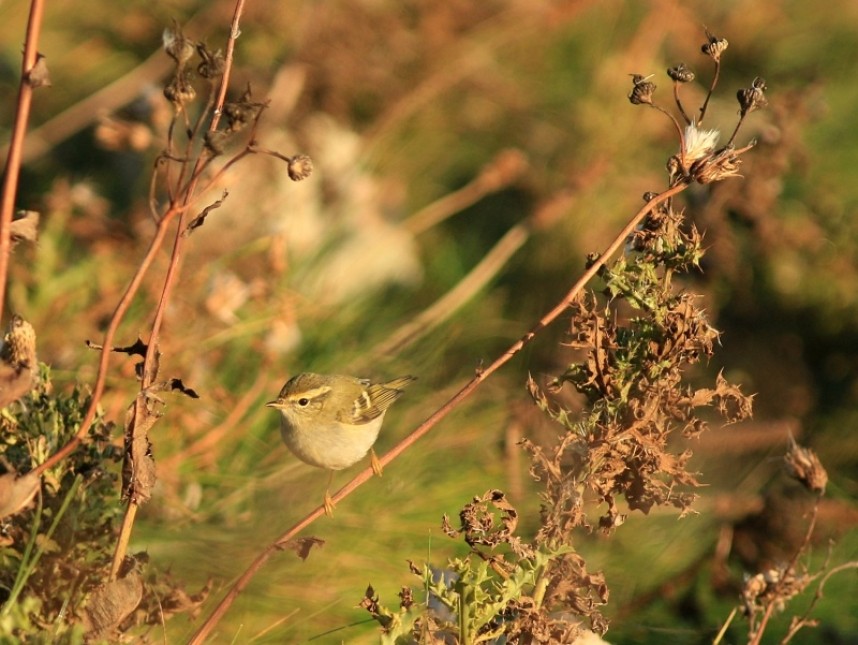
One of the most unexpected but magical of nocmig records – a Yellow-browed Warbler! © Mark Pearson
So, an amazing first year, with Stone-curlew, Dotterel,Yellow-browed Warbler, Quails, Bitterns, Short-eared Owl, multiple Tundra Bean and many White-fronted Geese, Little Egrets, Great Northern Diver, Ring Ouzels, Wood Sandpipers, huge movements of other thrushes and geese, a mouth-watering variety (and numbers) of waders, migrating Sylvia warblers and so much more – all in the dead of night via little battery-powered recorders. So much learned, so much still to learn, and so much added to our understanding of migration here on the magical Yorkshire coast.
YCN Birding/Wildlife Guide
For those who want to give it a go (and I'd recommend it to everyone), here's some useful links and resources:
For a great how-to guide (equipment, setting up analysis software, pitfalls etc.) the Nocmig website is a must
For a perfect introduction to nocmig and how to get started, watch Simon Gilling's BTO talk here
For a (significantly less professional!) introduction into nocmig from a beginner's perspective, see my Migweek talk here
For a deeper dive into this magical world, and for pioneering ID discoveries and tips, visit the Sound Approach website here
For regular summaries of my nocmig adventures, see the blog here



 Back to Blog
Back to Blog
